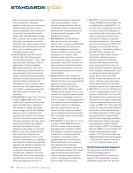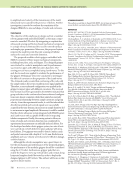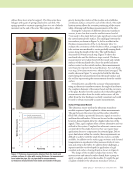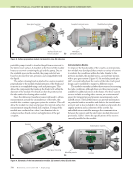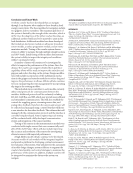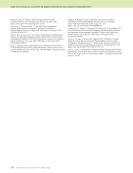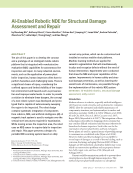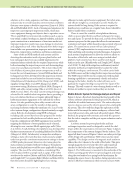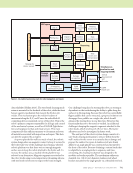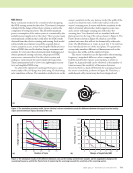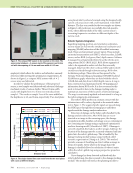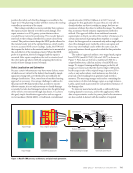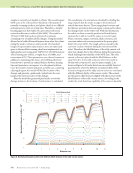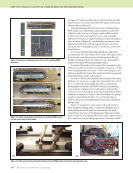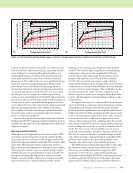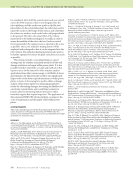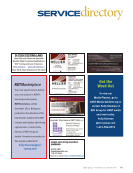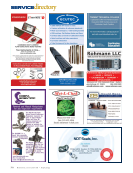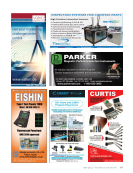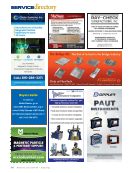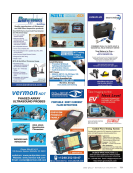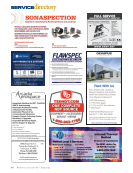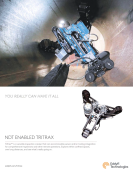732 M A T E R I A L S E V A L U A T I O N • J U L Y 2 0 2 1 Inspection Modules The purpose of the crawler is to provide information regarding the structural integrity of key pipeline components in fossil energy power plants. Although cameras will be incor- porated into the front and rear modules, additional modules have been developed to house inspection sensors and are described in the following subsections. Ultrasonic Transducer Module One of the sensors that will be used to assess the integrity of the tubes is an ultrasonic transducer sensor. A module has been developed that will house and deploy the ultrasonic transducer sensor for tube thickness measurements. The module will be used to measure the thickness at any location within the tube. To move the sensor radially to the inner surface, a deployment mechanism was developed. The mech- anism utilizes two micromotors connected to a gearbox and a lead screw. The lead nut is attached to a housing for the ultra- sonic transducer sensor and translates along the lead screw, converting the rotary motion from the motors to a linear motion for the sensor. To aid in obtaining thickness measurements at different circumferential locations, a spur gear system was added. A stationary spur gear is mounted on the front end of the module and acts as the output shaft. The input shaft gear, connected to a micromotor, spins with the module. A set of bearings permits the rotation and reduces the friction between the moving parts. This mechanism provides a full 360° rotation of the modules and provides a means for the ultrasonic transducer sensor to measure the tube thickness at any radial location. A schematic of the module highlighting the major components is shown in Figure 6. To keep the module centered and maintain stability during the rotations, a stabilization system is included that ME TECHNICAL PAPER w robotic inspection of small-diameter superheater pipes 0 0 2 4 6 0.2 0.4 0.6 Time (s) 0.8 1 1.2 0 0 2 4 6 0.2 0.4 0.6 Time (s) 0.8 1 1.2 0 100 120 140 160 0.2 0.4 0.6 Time (s) 0.8 1 1.2 l θ l Figure 5. Gripper component motion: (a) lead screw displacement (b) linkage rotation (c) gripper pad displacement. (a) (b) (c) Ultrasonic sensor Spur gear housing Linear actuator Stabilization system Figure 6. Ultrasonic transducer module schematic: (a) isometric view (b) side view. (a) (b) Displacement (mm) Displacement (mm) Rotation (degrees)
J U L Y 2 0 2 1 • M A T E R I A L S E V A L U A T I O N 733 utilizes three lever arms for support. The three arms have linkages with a pair of springs attached to each link. The springs provide a constant opposing force to a set of wheels mounted on the end of the arm. This spring force offsets gravity during the rotation of the module and establishes continuous surface contact for each of the wheels. The stabi- lization system allows for accurate positioning of the sensor while obtaining wall thickness measurements of the tube. During the evaluation of different ultrasonic transducer sensors, it was clear that even the smallest sensor head of 7 mm used in this study did not make significant contact with the curved internal tube surface. The small gap between the two surfaces, as shown in Figure 7a, led to an offset in the thickness measurements of the 5 cm diameter tube. To evaluate the consistency of the thickness offset, a stepped steel tube section was machined to create gradually varying thick- nesses along the length of the tube. The wall thickness decreased 0.198 mm at each step. Figure 7b shows the machined tube and the thickness steps created. Thickness measurements were taken from both the inside and outside surfaces of the machined tube. Since the probe had more surface contact on the outside surface, these measurements were found to represent the actual thickness. For each thick- ness step, 20 measurements were obtained and averaged. The results, shown in Figure 7c, were plotted with the blue line representing the measurements from the inside surface and the red line representing the measurements from the outside surface. Several factors can affect the accuracy of measurements using an ultrasonic transducer sensor: the angle of incidence, the couplant, diameter of the sensor head, and the curvature of the pipe. Results from this analysis show that although the measurements taken from the inside surfaces were off, the offset from the true thickness was fairly consistent and could be used to obtain reasonably accurate measurements. Surface Preparation Module The ultrasonic sensor used in the ultrasonic transducer module requires a liquid couplant to obtain measurements. The gap between the sensor tip and the surface should be filled with a fluid to permit the ultrasonic signals to travel to and from the wall surface. Water can be used as the couplant however, denser liquids allow for a higher refraction of the signals. Thus, a gel couplant offers a better alternative and was utilized in this system. Couplant-free ultrasonic sensors were considered for this study however, they can require large application forces to compensate for potential gaps. Due to space limitations within the crawler, these requirements are difficult to achieve with the small electric motors currently available. In addition to the surface gap, moisture and elevated temperatures in superheater tubes increases levels of corro- sion and creep in the tubes. To address these challenges, a separate module was developed for application of a gel couplant and surface-cleaning brush as shown in Figure 8. The design of the module includes four motors. The motors rotate and extend a surface brush, drive a pump to apply a couplant, and rotate the module. To apply the gel couplant needed for the ultrasonic transducer sensor, a 0 2 1 1.5 2 2.5 3 3.5 4 4.5 5 5.5 4 6 Pipe step 8 10 12 Inside measurements Outside measurements Figure 7. Thickness measurements obtained from the inside and outside surfaces of a tube with varying thickness: (a) measurement from inside the pipe (b) cut pipe used for measurements (c) thickness measurements from inside and outside of the pipe. (a) (b) (c) Wall thickness (mm)
ASNT grants non-exclusive, non-transferable license of this material to . All rights reserved. © ASNT 2025. To report unauthorized use, contact: customersupport@asnt.org



























































